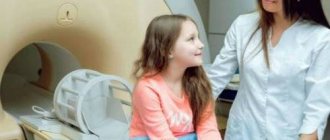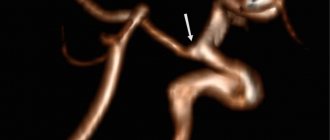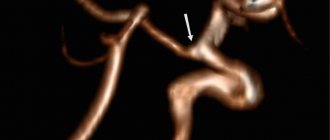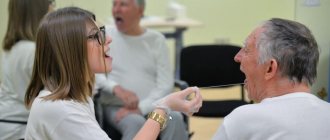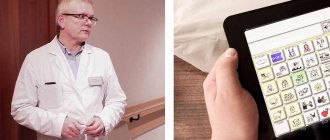Forms of aphasia
In the first days after a cerebrovascular accident, speech disorders in patients may manifest themselves in the form of total aphasia
: the patient does not speak and does not understand speech addressed to him.
Total aphasia after a few days or weeks may be replaced by sensory
or
motor aphasia
: the patient begins to understand speech addressed to him, but communicates with others using a speech “embolus” - a stereotypically repeated sound combination, syllable or word, sometimes well intoned.
There are several forms of aphasia
However, two main
forms of aphasia
:
- sensory
- motor
Diagnostic methods of various forms
At the first examination, the specialist examines the patient’s medical history and collects his complaints about his health: duration of the pathology, characteristic sensations, previous events, etc. If the patient is unable to describe his problems, relatives are involved in the diagnostic process. Further diagnostic measures include:
- a thorough neurological examination: examination of speech disorders, assessment of facial asymmetry, drooping of the corner of the mouth, incomplete squinting of the eyelids, deviation of the tongue, weakness in the limbs and changes in the nature of reflexes;
- examination by a speech therapist in order to clarify the nature of the speech disorder and plan measures for its further correction;
- electroencephalography to assess the activity of various parts of the brain and its changes under the influence of various diseases;
- computer or magnetic resonance imaging, which clarifies the layer-by-layer structure of the brain, identifying possible disorders and the presence of traces of hemorrhages, inflammation, tumor processes, etc.;
- magnetic resonance angiography to clarify the integrity of blood vessels and detect aneurysms, stenoses, occlusions and other vascular disorders.
Sensory aphasia
Wernicke's sensory aphasia
is a violation of the understanding of speech, both someone else’s and one’s own, while maintaining the ability to speak.
Occurs when the left temporal lobe of the brain is damaged. As a rule, the patient speaks quite willingly and a lot, but due to the loss of understanding of what he hears, he does not understand either himself or those around him. The form of sensory aphasia
is characterized by two main features:
- the patient’s speech is incomprehensible to others due to the lack of meaning in it (misunderstanding of one’s own speech leads to loss of control over it, the patient invents new words, replaces letters or syllables in existing ones, swaps words, pronounces incoherent strings of words and sentences)
- the speech of others and his own is incomprehensible to the patient (due to impaired perception of sound, loss of distinction in the sound composition of words, the patient does not understand the meaning of what he hears)
General information about treatment
It is possible to cure recurrent sensory aphasia and restore a person’s ability to perceive the speech of others and participate in dialogue. To do this, when the first signs of a disorder appear, you should contact specialized specialists: a neurologist, speech therapist, or speech pathologist. The problem is eliminated conservatively and surgically, during a neurosurgical operation.
At the initial stage of diagnosing sensory aphasia, specialists assess the severity of the patient’s condition during a conversation and pay attention to certain aspects:
- whether the person is aware of the situation during the conversation;
- how to navigate the situation;
- can he express his opinion, talk about his thoughts;
- Are there speech automatisms?
MRI is used as the main diagnostic method. This study allows you to clearly visualize the state of nerve tissue. After the initial examination, individual areas of the brain, the temporal lobes, are visualized. To assess blood flow, a scan of the vessels of the neck and brain is performed, this allows one to assess the severity of the pathology.
Inpatient therapy. In the early stages, the impact consists of primary care and adaptation, eliminating symptoms and combating the cause. After the ability to perceive sounds is restored, rehabilitation measures are carried out.
For therapy, nootropic agents and antihypoxic drugs are used. The use of medications is sufficient if the cases are not advanced. In case of aneurysms and tumors, it is not possible to restore the ability to perceive speech without surgical intervention.
Motor aphasia
Broca's motor aphasia
is a violation of the ability to speak while maintaining the ability to understand speech. Occurs when the frontal lobe of the brain (Broca's motor speech center) is damaged. The patient has difficulty pronouncing or does not pronounce words, mainly pronouncing simple words or syllables. The main features of the form of motor aphasia are:
- the patient’s speech is poorly distinguishable, but is often understandable and meaningful, accompanied by eloquent gestures (the patient has difficulty pronouncing and moving from one word to another)
- the speech of others is well understood by the patient
Causes of aphasia
The main causes of aphasia:
- traumatic brain injuries;
- hemorrhages;
- inflammation, infectious diseases of the brain (meningitis, encephalitis);
- tumor formations;
- deterioration of blood circulation in the brain as a result of problems with blood vessels.
The severity of speech impairment depends on:
- extent of damage;
- features of deterioration of blood circulation in brain tissue;
- states of brain areas that take on the functions of the affected centers.
Treatment of aphasia
Treatment of aphasia
in most cases it is successful. There are special speech restoration programs for different forms of aphasia, which are differentiated. In the process of individual work with patients with aphasia, a speech therapist modifies the techniques and methods of correctional pedagogical work available in the arsenal of defectology, bringing his own individual experience.
Treatment of aphasia
consists not only in restoring ability, but also in restoring the affected part of the brain, which is the cause of the speech disorder.
If you or your loved ones have speech problems, make an appointment with a speech therapist. At the “Your Health” clinic, appointments are conducted by a highly qualified specialist with many years of experience in the specialty “Speech Therapy” Ella Borisovna Rothbert, who will help you choose the optimal method of speech correction.
There are several forms of aphasia, which are characterized by a violation of either speech understanding or speech reproduction. In severe cases of aphasia, a person’s ability to both understand others and speak is impaired. This speech disorder most often occurs in older people as a consequence of severe brain diseases (stroke, tumors) or brain injuries.
In children, aphasia is diagnosed when organic brain damage occurs after the child has mastered speech. In this case, aphasia leads to disruption of its further development, sometimes to the collapse of formed speech. Aphasia often leads to profound disability.
The possibilities for compensation for speech and mental disorders in children and adults are sharply limited. Adults with aphasia, as a rule, lose their profession and have difficulty adapting to everyday life. Misunderstanding of others and the inability to express one’s desires cause behavioral disorders: aggression, conflict, irritability.
Types of aphasia, causes and correction of aphasia
What is aphasia?
How serious is this speech pathology? Forms of aphasia: motor, sensory and total aphasia. Aphasia correction in Almaty. What are the causes of aphasia? Can aphasia be corrected? Is it possible to help adults with aphasia, or how successfully can aphasia be corrected in children? You will find detailed answers to all these questions in this article. Aphasia is one of the complex speech deviations of organic, central origin. The disorder, unlike other disorders, is caused by damage to the areas of the brain responsible for speech. The causes of such damage may be deterioration of blood circulation in the brain, traumatic brain injury, rheumatoid heart defects, thromboembolism, strokes, etc. Aphasia usually develops in people of old age, but can also affect young people and children.
With aphasia, partial speech impairment or complete loss may be observed.
The term "APHASIA" comes from the Greek language. The particle “a-” means negation, “phasis” means speech.
Aphasia appears when a person has already fully formed speech as a result of damage to the speech areas of the brain: the frontal, parietal, and temporal lobes.
Bringing speech back
Correction of sensory aphasia primarily includes drug support - continued treatment of the disease that led to the speech disorder. The primary treating physician for such patients is a neurologist. Its task is not only to monitor the continuation of treatment, but also to monitor whether other neurological disorders develop, which may either be a consequence of a previous illness or injury, or arise for other reasons. The doctor decides which medications are used individually in each case. If you want to add something to your treatment (most often you want to add vitamins), be sure to discuss this with your doctor! Accurate implementation of the neurologist’s prescriptions is the basis for success in speech rehabilitation.
An important component of treating sensory aphasia is working with a speech therapist. It happens, especially in children, that speech is restored on its own, but no one can predict whether this will happen or not. Therefore, remedial training for sensory aphasia is an essential part of therapy. The speech therapist will teach parents what exercises to do at home and what to watch for so that rehabilitation goes faster and more successfully. The main task of relatives is to organize a comfortable environment for the patient and learn to communicate with him. The exercises that the speech therapist asks you to do at home will help with this. Don’t force things, the brain needs time to restore neural connections. It is extremely important to dose the load; overwork will not benefit the baby.
Our center’s specialists have extensive experience in restoring lost speech in children. They are familiar with methods that are recognized as effective by the global speech therapy community, and choose from a variety of methods those that will work best for a particular child. We achieve results whenever this is possible in principle - and in children it is possible to restore lost speech in most cases.
Clinical picture
Aphasia is characterized by a variety of disorders that manifest themselves more or less actively depending on the clinical form of aphasia. The most common manifestations of aphasia are the following symptoms:
- The patient misses phrases and individual words, most often nouns;
- Repetition of the same phrases or phrases;
- Slow speech of the victim, with pronounced intervals between sentences, or vice versa, the victim’s speech becomes fluent, illogical, turning into “porridge”;
- The presence of paraphrases is a descriptive characteristic of the semantic load of a word. Speech becomes descriptive;
- A person suffering from aphasia cannot remember the name of the object or object in question, but knows its function and appearance.
- The victim's speech becomes expressive and contains a large number of verbs.
It is important to note that the patient most often easily remembers the name of an object when prompted or in context, for example, if you name the first syllable of the desired word, the patient will easily remember its ending.
Therapeutic measures
In the treatment of aphasia, as with any other neurological pathology, the leading role is played by the possibility of using pathogenetically based therapy. Only after a fully completed diagnostic examination can targeted therapy be prescribed.
The first step, regardless of the form of aphasia, is to eliminate life-threatening factors. Intensive therapy measures are carried out, the patient is stabilized, and only after this the stage of aphasia treatment and subsequent rehabilitation begins.
In the treatment of aphasia, it is important to activate the metabolic imbalance that has arisen in the brain as quickly as possible. The following groups of drugs are used for this:
- Cerebroprotectors and nootropics: Piracetam, Nootropil, Cerebrolysin.
- Vascular drugs: Octavegin, Vinpocetine and analogues.
- B vitamins, natural antioxidants and neuroprotectors.
- Anticoagulants or coagulants, depending on the form of vascular lesion.
A very important point is the conduct of physiotherapeutic procedures. Therapeutic electrophoresis, magnetic therapy, acupuncture, therapeutic massage and physical exercise are used. All methods make it possible to increase the effectiveness of basic therapy and accelerate regenerative and reparative processes.
Treatment options
A combination of medicinal and surgical treatment methods allows you to cope with the pathology:
- surgical removal of the tumor site, tissue with consequences of hemorrhage or purulent contents;
- antibacterial therapy;
- taking anticonvulsants to prevent epileptic seizures;
- taking medications to normalize blood pressure, cerebral blood flow and metabolism.
A mandatory part of therapy is sessions with a speech therapist to correct speech disorders.
Aphasia: symptoms, types, diagnosis and treatment
Aphasia is a partial or complete loss of already formed speech caused by local organic damage to speech areas in the brain. A person with this pathology experiences serious difficulties in communicating with other people, and his perception of the world around him is disrupted. Patients with sensory aphasia cannot understand words or recognize auditory, visual, or tactile symbols. In patients with expressive aphasia, the ability to speak is impaired in terms of relative speech understanding.
Types of aphasia, their symptoms and features
Aphasia in medical terminology refers to a neurological disorder associated with impairment of cognitive functions such as speech, writing, memory, orientation in time and space, drawing, comprehension and awareness, as well as attention and action.
The main manifestation of aphasia is problems with understanding and pronunciation of speech. In some cases, the perception of visual information is impaired.
Aphasia develops only when a person has formed speech, i.e. this diagnosis is given to children over 3-4 years of age.
Today there are several types of classification of aphasia. According to anatomical, psychological and linguistic criteria, a classic division of forms of the disease is distinguished: neurological, linguistic, etc.
A.R. Lurie fully opened up the issue of dividing aphasia into types, ultimately identifying six strains of this disease. Its classification is still considered the most complete and accepted in world practice. According to this neuropsychological division, the following forms of aphasia are distinguished:
- afferent motor;
- efferent motor;
- acoustic-gnostic (sensory);
- acoustic-mnestic;
- semantic aphasia;
- dynamic.
These forms are generally divided into three main groups. Thus, this rotational and dynamic form of aphasia is classified as a group of motor disorders. A distinctive feature of this type of disease is the lack of expressive speech, i.e. active oral expression.
Forms of aphasia
Acoustic-gnostic and semantic aphasia refers to a group of disorders in which a person is unable to understand spoken language. If the patient cannot count individual objects, acoustic-acoustic aphasia or an amnestic form of the disease occurs.
Different parts of the brain are responsible for one or another element of our speech structure. This is where the lesion is located because the form of the disease will depend on it. The division of aphasia into types is explained differently and according to the degree of its severity. With the general form of the disease, complete recovery of the patient is almost impossible.
General characteristics of aphasia
The prognosis for the development of the disease depends on a number of factors - severity, age of the patient, location. There is no specific treatment for this problem. Correction of speech disorders is used to promote recovery.
Etiology, classification and pathophysiology of aphasias
Aphasia is observed in diseases of the brain of various etiologies: vascular lesions, inflammatory, tumor, traumatic, atrophic processes in the brain - Pick's disease, Alzheimer's, etc. Short-term apathetic seizures can occur during cerebral crises, migraines, epilepsy. It is studied by specialists of various specialties - neuropathologists, physiologists, psychologists, neurosurgeons, speech therapists, etc. However, a number of unclear and contradictory issues remain in the complex problem of aphasia.
Symptomatic manifestation of aphasia
Aphasia in children is not as common as in adults. It is detected in approximately 1% of children, more often in boys. Symptoms, diagnosis and treatment are no different from those of the disease in adults. Children are usually diagnosed with sensory aphasia, which belongs to the motor group of diseases. Childhood aphasia is usually diagnosed by a neurologist.
Symptoms of pathology found in children:
- speak very little (an important sign);
- the speech is simplified, there are no complex phrases and words;
- the child answers questions clearly and briefly;
- speech can be very fast and emotional, incoherent, incomprehensible to others and devoid of meaning;
- The child has difficulty understanding the spoken language of others.
Features of correction of speech disorders in the acute period
Child care involves the use of special programs conducted by a speech therapist. Treatment is aimed at compensating speech mechanisms using direct and indirect methods. Direct methods are performed in the early stages and involve activation of the reserve capabilities of brain cells.
Indirect methods should compensate for lost functions through functional restructuring of parts of the brain. The materials used were cards, pictures, special computer programs, and speech therapy exercises. The effectiveness of training depends on a number of factors:
- form of the disease;
- heaviness;
- duration of illness;
- cause of occurrence;
- child's age;
- the moment of initiation of rehabilitation therapy.
A child's brain is more flexible than an adult's brain. For milder lesions, healing occurs more quickly. With mild structural aphasia, speech ability is restored within 3-5 weeks, with moderate severity it may take 1-6 months. If you have Landau-Klepner syndrome, you will need medication in addition to training.
What is aphasia. Types of speech disorders and treatment methods
Aphasia is a complete or partial loss of the ability to convey thoughts in words. A person experiences difficulties in communicating with others, and problems begin in the worldview around him. The term was first coined in 1864 by the French physician Armand Trousseau.
In clinical neurological practice, it is customary to distinguish the following types of aphasia:
Dynamic, occurs with organic damage to the posterior parts of the anterior lobes. This is expressed in a violation of the plan of utterance, which leads to both a violation of the perception of speech and a violation of its formation.
Acoustic-gnostic, expressed in damage to the analytical area of Wernicke. It is characterized by phonemic hearing loss. A person with this form ceases to correctly perceive the interlocutor’s speech;
Acoustic-mnestic expression - a violation of the visual representation of an object and loss of auditory memory. Such aphasia manifests itself in speech poverty, omission of speech parts and the presence of paraphrasing speech errors;
Amental-semantic, with damage to the posterior temporal part of the brain. Understanding of complex grammatical structures is impaired, speech simply does not suffer;
Efferent motor aphasia also occurs, which manifests itself when Broca's area is damaged, and the patient develops articular or dysplexy;
Afferent motor aphasia developing with injury to the postcentral sulcus. The main disorder in this form is kinetic speech disorder or severe difficulty in speech function associated with the formation of certain sounds. The patient also has a disturbance in the perception of speech information when reading and writing.
Treatment of aphasia
In the treatment of aphasia, as with any other neurological pathology, the possibility of using pathogenic therapy plays a dominant role. Only after a complete diagnostic examination can targeted treatment be prescribed.
The first step, regardless of the form of aphasia, is to eliminate the life-threatening factor. Intensive treatment is carried out, the patient’s condition is stabilized, and only after this the aphasia treatment phase and subsequent rehabilitation begin.
When treating aphasia, it is important to activate the metabolic imbalance created in the brain as quickly as possible.
A very important point is the implementation of physiotherapeutic procedures. Therapeutic electrophoresis, magnetic therapy, acupuncture, therapeutic massage and physical exercise are used. All methods allow you to increase the effectiveness of the main treatment and speed up the processes of regeneration and recovery.
Rehabilitation of patients with aphasia
The restoration of speech functions occurs gradually. Treatment of aphasia includes not only help from a speech therapist, massage and special medications, but also comprehensive long-term rehabilitation, the duration of which directly depends on the severity and form of aphasia.
The main objectives of rehabilitation of the speech apparatus are speech rehabilitation and social rehabilitation of the patient with the goal of full integration into society. An earlier appearance contributes to the complete restoration of speech skills and the establishment of its natural rhythm.
Maximum effectiveness of rehabilitation in the first three months. The duration must be at least three hours per day for at least five months. In severe cases, this can take anywhere from six months to two years. The choice of rehabilitation type, duration, and exercises used is determined according to a personal plan by speech development specialists.
Rehabilitation of patients with aphasia
In the early period, rehabilitation should be carried out in a passive state. But in later stages the patient must take an active part in this. The acute phase of rehabilitation is also distinguished, it consists of:
- Establishing a trusting relationship between the speech therapist and the patient;
- Study of the patient's neuropsychological characteristics;
- Study of the emotional-voluntary area;
During this period, classes are psychotherapeutic in nature. Classes are conducted in a lower tone or even a whisper. In the third week, the speech therapist has a complete picture of speech disorders. The rehabilitation procedure for a speech therapist is outlined here. In the early stages of rehabilitation they use:
- Stimulation of speech understanding;
- Activation of expressive speech;
- Preventing the development of agrammatism;
- Stimulation of reading and writing skills.
At later stages of speech therapy, speech compensation is used. Speech needs to be restored not in its previous form, but in a change. One form of aphasia may present differently in different patients and vary in its symptoms.
Rehabilitation of patients with late period aphasia
Exercises and tasks for the late period of speech rehabilitation are determined on an individual basis.
In the sensory acoustic-gnostic type, work is used to restore phonemic hearing, to restore vocabulary, to restore writing, to compensate for agramtism.
In case of acoustic-medical aphasia, a speech therapist performs restoration of speech, hearing, memory and speech abilities.
In the semantic form of aphasia, impressive agrammatism is compensated.
With motor aphasia, efforts are aimed at eliminating violations of type, practice, and fractionation.
Successful rehabilitation work is carried out by presenting plans for the ability to speak.
The refined dynamic work is aimed at the inertia of their speech utterances.
The patient's emotions are important at all stages. They desperately need conversations with family, loved ones, and friends. Recovery is faster if the patient is morally motivated and confident in obtaining a positive result.
In the first two years after a stroke or injury, the patient should be under the supervision of the attending physician. Classes with a speech therapist last about two to three years.
Forms, types (classification) of aphasia
Today there are several types of classification of aphasia. Based on anatomical, psychological and linguistic criteria, a classic division of forms of the disease is distinguished: neurological, linguistic, etc.
A. R. Luria most fully revealed the issue of dividing aphasia into types, revealing as a result six strains of this disease. Its classification is still considered the most complete and accepted in world practice. According to this neuropsychological division, the following forms of aphasia are distinguished:
- afferent motor;
- efferent motor;
- acoustic-gnostic (sensory);
- acoustic-mnestic;
- semantic aphasia;
- dynamic.
These forms are usually divided into three large groups. Thus, these forms of aphasia are classified as movement disorders. A distinctive feature of this type of disease is the lack of expressive speech, i.e. active oral expression.
Acoustic-gnostic and semantic aphasia refers to a group of disorders in which a person is unable to understand spoken language. If the patient cannot count individual objects, acoustic-acoustic aphasia or an amnestic form of the disease occurs.
Different parts of the brain are responsible for one or another element of our speech structure. This is where the lesion is located because the form of the disease will depend on it. The division of aphasia into types is explained differently and according to the degree of its severity. With the general form of the disease, complete recovery of the patient is almost impossible.
Sensory aphasia
Sensory aphasia has many synonyms for its name: memory aphasia, fluent aphasia, acoustic-gnostic aphasia, Vernitsa aphasia, or simply word deafness. The pathology consists of damage to the auditory cortex of the cerebral hemispheres, that is, the vernacular region. The pathology is based on the difficulty of recognizing the sound composition of a word. The main defeat in this type of aphasia is a lack of understanding of the meaning of a word, while a person can freely repeat words and hear them, the whole point is a lack of understanding of their meaning. With severe lesions in the vernika area, the audible speech of another person is perceived as white noise.
Signs and causes of sensory aphasia
Sensory aphasia can occur for a variety of reasons. The cause of this disease can be both cardiovascular diseases and injuries to the head and central nervous system. The most common causes of sensory aphasia:
Acute and transient circulatory disorders in the brain, for example, embolism or stroke. Embolism may be the result of an unstable atherosclerotic plaque in the bed of one of the main arteries or thrombosis extending from the left atrial appendage due to arthritis.
Most often, head injuries occur in road traffic accidents. Traumatic brain injury can lead to simultaneous damage to the structures of the cortex and subcortex of the brain or to delayed injury with the development of cerebral edema.
Oncological processes of cranial localization. Benign or malignant tumors can be a significant factor in the development of sensory aphasia.
It is important to note that the following branches that enter the pelvis of the midbrain most often participate in the formation of the lesion:
- Inferior branch of the middle cerebral artery;
- Posterior temporal artery;
- Artery of the angular gyrus.
Forms of sensory aphasia
There are several significant clinical forms of sensory aphasia that are characteristic of sensory aphasia. When additional pathological foci of substance in the cerebral cortex connect with the affected area of vernacular speech, new symptoms of impaired speech function appear. In this context, neurologists note the following forms of aphasia:
Semantic aphasia
With this aphasia, there is a violation of the recognition of logic and the relationship between words and objects. This is especially true for spatial perception.
Acalculia-aphasia
In this case, the key symptom is the formation of a local impairment of speech function. That is, account violations. At the same time, the patient’s other forms of speech are not affected.
Sensorimotor aphasia
Insufficient speech understanding is associated not only with damage to the auditory surgeon's cortical region, but also with joint dysfunction. In other words, a person cannot correctly evaluate gestures when pronouncing a certain word on behalf of another person. So it is with me. The patient himself is unaware of his illness and becomes very irritated in situations where he is not understood.
Total aphasia
With this option, the victim experiences a combination of various types of functional disorders of speech function. The patient has impairments in written and oral speech. In this case, the patient does not catch someone else’s speech and cannot answer anything himself.
Symptoms
Clinical manifestations of sensory aphasia have a number of specific characteristics that help in quick and effective differential diagnosis. These signs include:
Fluent speech or logorrhea with numerous expressions and allegorical paraphrases. The patient misses nouns; I compensate for such speech disorders with a large number of verbs, prepositions and combinations. Speech becomes incorrect, but not informative.
“Slang aphasia” is a continuous stream of neologisms, proverbs, sayings and paraphrases.
Intense agitation leading to the development of a paranoid state.
Impaired understanding and perception of speech. The patient has difficulty or does not receive simple questions, such as being asked to introduce himself or say who he is, but can follow simple commands, such as turning his head or introducing himself. It is also important to note that the patient does not understand his problem and is very upset when the interlocutor does not understand his speech well.
Correct mianopsia or mianopsia of the upper quarter. Loss of visual field – When reading books, the victim will not give full attention to the left page when reading the text.
We smooth out the nasolabial fold - the face becomes a mask.
Impairment of written speech.
Pure (subcortical) sensory aphasia is also different, where only understanding of spoken language is impaired, but understanding of written information, called meaning, is preserved. There is also another form - transcortical sensory aphasia, which is characterized by the preservation of the ability to repeat speech orally, despite the lack of perception and understanding. The main problem is that the patient hears the address to his person, but cannot interpret the meaning of the interlocutor’s words. The native language is perceived as a foreign language.
Motor aphasia - “central control” is impaired, and the language is not obeyed!
With local circulatory disorders, the clinical manifestations of speech disorders, as a rule, overlap with the repressed area of the brain. According to the existing classification, seven forms of pathology are distinguished, three of which are different forms of motor aphasia, that is, disorders of expressive speech. In other words, a patient with motor aphasia has a violation of joint speech due to injury to the corresponding center of the brain.
Forms and signs of motor aphasia
Its forms are as follows:
- Motor afferent, or motor afferent kinesthetic (articular).
- Motor efferent, or Broca's motor aphasia (verbal).
- Motor dynamic as one of two types of transcortical motor aphasia.
Complex (mixed) forms of aphasia are quite common. The development of one form or another, the nature of the course of the pathology and the healing time of motor aphasia are mainly influenced by factors such as:
- localization of the lesion and the extent of its extent;
- the nature of the circulatory disturbance in areas of the brain;
- the degree of possibility of compensatory functions being carried out by undamaged areas of the brain, which depends on their condition.
In principle, the severity of the condition (described in detail in a small section of each of these forms) of the pathological condition also depends on these factors - severe (and even complete) motor aphasia can occur.
Treatment of motor aphasia (general principles)
Speech disorders create significant restrictions in terms of interaction with the social environment, lead to disability and a decrease in the quality of life not only for the patients themselves, but also for their loved ones, increase the material costs of treatment and treatment, and cause depressive conditions. conditions that significantly complicate the recovery process and worsen the overall prognosis of the disease. When comparing stroke patients without aphasia and with aphasia, it was noted that among the latter, the duration of involuntary hospitalization and mortality were higher.
The prognosis, degree of recovery and duration of rehabilitation depend mainly on factors such as:
- Cause of illness;
- Type and location of damage;
- The degree and depth of damage to brain tissue;
- Form of aphasia and its severity;
- The condition of the brain tissue surrounding the lesion - the presence of parallel pathological changes in small blood vessels (microangiopathy), previously suffered degenerative processes, etc.;
- Age, gender of the patient and the presence of “leftists”;
- Level of education and knowledge of foreign languages;
- Relevance, adequacy and duration of rehabilitation treatment.
All of these factors have a direct impact on the extent to which the recovery process is independent and uncontrollable, which can lead to an inability to fully restore speech function or controlled intentional therapy, that is, speech. Their correct combination is very important.
Treatment of dynamic motor aphasia
- Treatment and rehabilitation methods for speech rehabilitation should be comprehensive and include:
- Treatment of the underlying pathology;
- Pharmacological support;
- Physiotherapy (cranial direct current stimulation and supracranial magnetic stimulation - to stimulate synaptic activity of areas);
- Therapeutic exercise and therapeutic massage;
- Intensive exercises for speech therapist;
- Help from a psychotherapist and psychiatrist.
The main task of pharmacological treatment is to compensate for the deficiency in the body of biologically active substances that affect the transmission and passage of nerve impulses (neurotransmitters), as well as nonspecific stimuli of higher mental processes in the brain.
For these purposes, it is recommended to prescribe several drugs that are modulators of various neurotransmission systems, from the group of serotonin reuptake inhibitors, dopaminergic drugs, neutropenic drugs - mainly created recently. (In addition, drugs are prescribed that improve blood flow to the brain and drugs that promote metabolic processes.
Non-drug rehabilitation measures should be carried out against the background of basic pharmacological treatment. Speech therapy sessions are now considered the “gold standard” for speech correction among such patients. Moreover, it is not the specific way of speaking at work that is important, but the frequency and intensity of the lessons.
In addition, it has so far become completely clear that only with an early start of classes with a speech therapist can one expect positive and stable treatment results. The process of restoring the speech function of a speech therapist should begin in the acute period of the disease (from 7-10 days after a stroke) and last from 6 months to 2-3 years or more, i.e. throughout the entire recovery period.
If you encounter aphasia, we strongly do not recommend that you self-medicate. By ignoring the opportunity to go to the hospital, you risk worsening the situation and depriving the patient with aphasia of the chance of recovery. On our website you can fill out the feedback form, and our specialists will soon contact you and do everything possible to help you cope with aphasia!
← Speech disorders
→ All about cerebral palsy
How to recognize the disease?
Sensory aphasia syndrome has an important feature: this disease does not arise out of the blue, there must be a reason. The patient himself may not know about it, not attach importance to it, or, due to a speech disorder, may not be able to talk about it. Therefore, modern research methods come to the rescue: computer (CT) and magnetic resonance (MRI) tomography, electroencephalography, and, if necessary, contrast angiography, which will help identify vascular pathologies.
In fact, sensory aphasia is a symptom of deeper disorders. But often, after eliminating the causes, speech is not restored immediately. This happens when the cortex of the speech centers is destroyed irreversibly, and it takes time for other parts of the brain to take over the functions of this area. When doctors are convinced that there is no danger to the patient’s life and health, it is time for rehabilitation: these classes are designed to speed up the process of formation of new neural connections.
Acoustic-mnestic aphasia
Cause
acoustic-mnestic aphasia - damage to the middle and posterior parts of the temporal region.
It is characterized by symptoms such as a decrease in auditory-verbal memory
due to inhibition of auditory control. When listening to each new word, the patient loses understanding of the previous one, hence the repeated repetition of the same syllable or word. An aphasic who suffers from the acoustic-mnestic form cannot repeat 3-4 words in a row with different meanings. For example, sky, hand, grass, spoon, repeats either the first or the last word. Phonemic hearing and correct articulation are preserved, which results in verbosity that compensates for communication difficulties. The nominative function of speech, retelling based on plot pictures, suffers. Misunderstanding of the meaning of words leads to verbal paraphasia - substitution of words in a sentence, merging one word into one in writing. Along with writing, counting and reading are impaired.
Up


